
The bass guitar, electric bass or simply bass, is the lowest-pitched member of the guitar family. It is a plucked string instrument similar in appearance and construction to an electric or acoustic guitar, but with a longer neck and scale length, and typically four to six strings or courses. Since the mid-1950s, the bass guitar has largely replaced the double bass in popular music.

An electric guitar is a guitar that requires external amplification in order to be heard at typical performance volumes, unlike a standard acoustic guitar. It uses one or more pickups to convert the vibration of its strings into electrical signals, which ultimately are reproduced as sound by loudspeakers. The sound is sometimes shaped or electronically altered to achieve different timbres or tonal qualities from that of an acoustic guitar via amplifier settings or knobs on the guitar. Often, this is done through the use of effects such as reverb, distortion and "overdrive"; the latter is considered to be a key element of electric blues guitar music and jazz and rock guitar playing. Designs also exist combining attributes of the electric and acoustic guitars: the semi-acoustic and acoustic-electric guitars.

A single coil pickup is a type of magnetic transducer, or pickup, for the electric guitar and the electric bass. It electromagnetically converts the vibration of the strings to an electric signal. Single coil pickups are one of the two most popular designs, along with dual-coil or "humbucking" pickups.
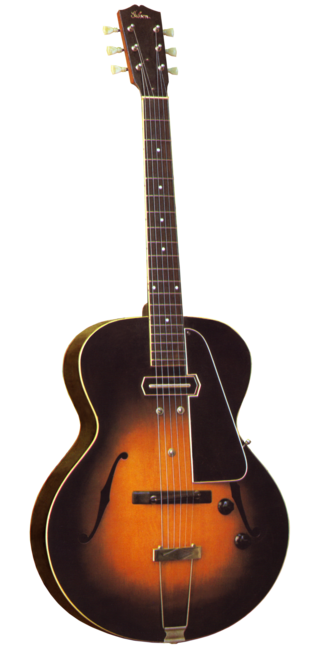
A semi-acoustic guitar, also known as a hollow-body electric guitar, is a type of electric guitar designed to be played with a guitar amplifier featuring a fully or partly hollow body and at least one electromagnetic pickup. First created in the 1930s, they became popular in jazz and blues, where they remain widely used, and the early period of rock & roll, though they were later largely supplanted by solid-body electric guitars in rock.

The Bigsby vibrato tailpiece is a type of mechanical vibrato device for electric guitar designed by Paul Bigsby and produced by the Bigsby Electric Guitar Company. The device allows musicians to bend the pitch of notes or entire chords with their pick hand for various effects.
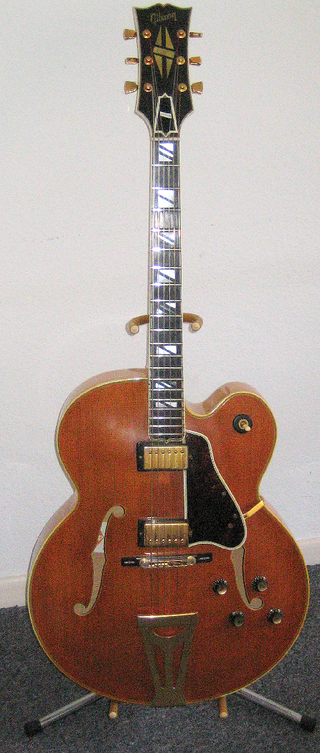
An archtop guitar is a hollow acoustic or semi-acoustic guitar with a full body and a distinctive arched top, whose sound is particularly popular with jazz, blues, and rockabilly players.
A vibrato system on a guitar is a mechanical device used to temporarily change the pitch of the strings. They add vibrato to the sound by changing the tension of the strings, typically at the bridge or tailpiece of an electric guitar using a controlling lever, which is alternately referred to as a whammy bar, vibrato bar, or incorrectly as a tremolo arm. The lever enables the player to quickly and temporarily vary the tension and sometimes length of the strings, changing the pitch to create a vibrato, portamento, or pitch bend effect. Instruments without a vibrato have other bridge and tailpiece systems.
Paul Adelburt Bigsby (1899–1968) was an American inventor, designer, and pioneer of the solid body electric guitar. Bigsby is best known for having been the designer of the Bigsby vibrato tailpiece and proprietor of Bigsby Electric Guitars.
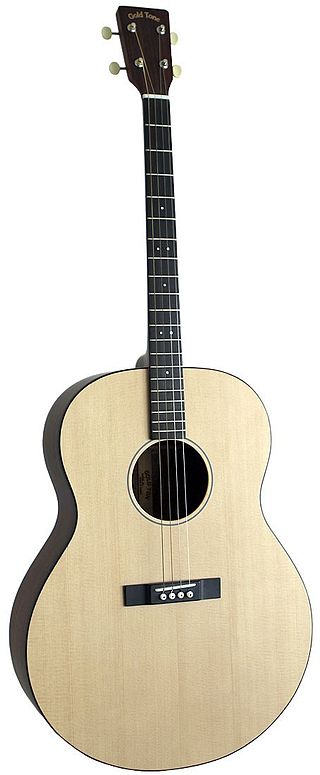
The tenor guitar or four-string guitar is a slightly smaller, four-string relative of the steel-string acoustic guitar or electric guitar. The instrument was initially developed in its acoustic form by Gibson and C.F. Martin so that players of the four-string tenor banjo could double on guitar.
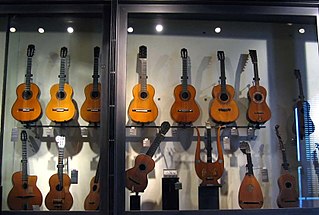
The following outline is provided as an overview of and topical guide to guitars:

A headstock or peghead is part of a guitar or similar stringed instruments such as a lute, mandolin, banjo, ukulele and others of the lute lineage. The main function of a headstock is to house the tuning pegs or other mechanism that holds the strings at the "head" of the instrument; it corresponds to a pegbox in the violin family. At the "tail" of the instrument the strings are usually held by a tailpiece or bridge. Machine heads on the headstock are commonly used to tune the instrument by adjusting the tension of strings and, consequently, the pitch of sound they produce.
A solid-body musical instrument is a string instrument such as a guitar, bass or violin built without its normal sound box and relying on an electromagnetic pickup system to directly detect the vibrations of the strings; these instruments are usually plugged into an instrument amplifier and loudspeaker to be heard. Solid-body instruments are preferred in situations where acoustic feedback may otherwise be a problem and are inherently both less expensive to build and more rugged than acoustic electric instruments.
Electric guitar design is a type of industrial design where the looks and efficiency of the shape as well as the acoustical aspects of the guitar are important factors. In the past many guitars have been designed with various odd shapes as well as very practical and convenient solutions to improve the usability of the object.

John Lennon's musical instruments were both diverse and many, and his worldwide fame resulted in his personal choices having a strong impact on cultural preferences.
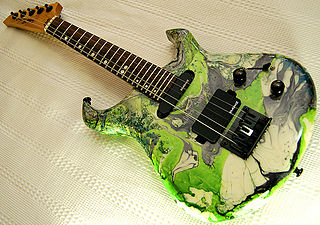
The Bahian guitar in Portuguese: guitarra baiana, pau elétrico is a Brazilian solid-body electric mandolin with either 4 or 5 strings, normally tuned GDAE and CGDAE, respectively, and has the scale of a cavaco, 6 String versions also exist.
Penco was a brand of guitars owned and manufactured by the Hoshino Gakki Co. in its factory of Nagoya, Japan. Ibanez guitars was another brand owned and manufactured by Hoshino Gakki. In the United States, Penco guitars were distributed by the Philadelphia Music Company.

Armandinho is a Brazilian composer and singer. He was born in Salvador, the son of Osmar Macêdo, from the world's first trio elétrico, the Trio Elétrico de Dodô e Osmar. In his early career, he played in his bands Trio Elétrico Mirim in 1962 and Hell's Angels in 1967.
The Fender Telecaster, colloquially known as the Tele, is an electric guitar produced by Fender. Together with its sister model the Esquire, it was the world's first mass-produced, commercially successful solid-body electric guitar. Its simple yet effective design and revolutionary sound broke ground and set trends in electric guitar manufacturing and popular music.

Bigsby is a brand of guitars and guitar accessories that operated as an independent company by Paul Bigsby until 1966 when it was purchased by ex-Gibson executive Ted McCarty. In 1999, the brand was acquired by Gretsch from McCarty, which owned it until 2019, when Bigsby was sold to Fender Musical Instruments Corporation.














